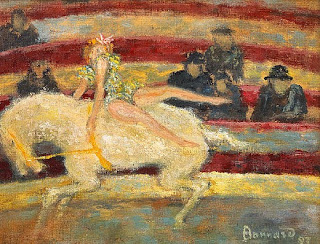As the title suggests, and anyone with a good eye for such things or a more than passing interest in Bonnard's overall project and life's work could tell you, the paintings that I've gathered here for reproduction, from various far flung sources across the Internet, are arranged thematically rather than chronologically.
Street scenes were an essential subject for Bonnard in the 1890s, which is when all of the paintings, above and below, were produced. They remained a major theme in his work, but he was especially drawn to them then. (Perhaps it’s because that’s where he first saw the woman with whom he would spend the rest of his life, happily and not. His first glimpse of Marthe is pictured in the second picture presented above, just below the charming and very early self-portrait, which comes first.)
This was the time when he was a member of Les Nabis and shared his ideas and methods with his close friends, Vuillard, Denis, Sérusier, Roussel, Vallotton, Ranson, Verkade, and their common masters, Gauguin, and Lautrec. It is especially fruitful for the young to work in groups, to immerse themselves in the confusing energy of the crowd, to learn to be social creatures. As we get older we may still want that contact, but find that too much of it is distracting. We don’t have as much energy within us to respond properly and so draw away from the vibrant street.
The domestic themes that took precedence more and more as he progressed through his life and work were already present at the beginnings of his career, but here, at the start, there is a greater sense of a wider social circle that is gathered within these homely spaces. As he got older, society shrunk, and the many women of his youth came to be represented, more often than not, by the lone Marthe at her table or in her tub.



































No comments:
Post a Comment